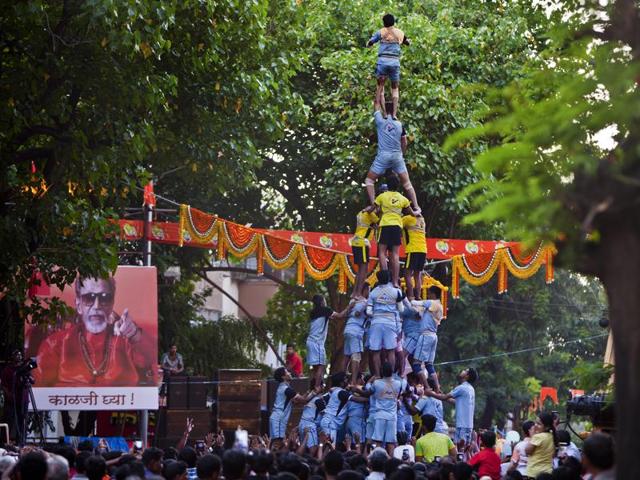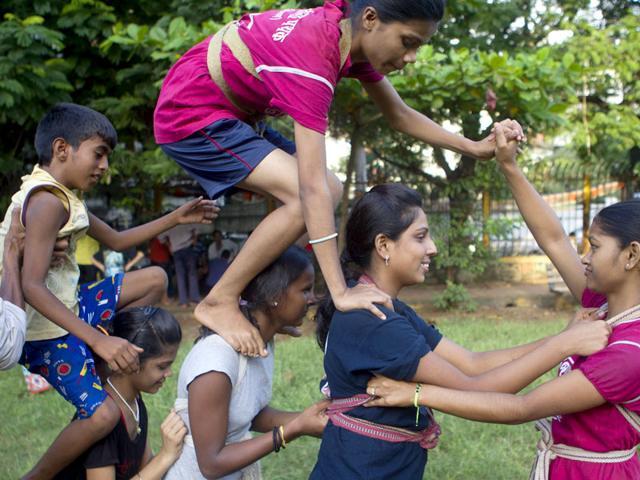Pride, politics and culture: Why Mumbai wants dahi handi festival to go on
City shocked after Supreme Court says children below 18 years of age cannot participate in the upcoming festival in Maharashtra.
There is a general feeling of disappointment among both the common people and social scientists, who want to keep the decades-old tradition alive, after the Supreme Court restricted dahi handi celebrations in Mumbai due on August 25 this year.

On Wednesday, the top court said that children below 18 years of age cannot participate in the upcoming dahi handi festival in Maharashtra.
The court said it was dangerous to allow small children to participate in such feats in its response to a clarification sought by the Maharashtra government over the August 2014 verdict that limited the height of such pyramids to 20 feet.
Lokmanya Bal Gangadhar Tilak, one of the tallest leaders of the Indian freedom movement, began the Ganesh Chaturthi celebrations in Pune and Maharashtra in 1894 as a means to defy the British ban on religious gatherings – the colonial rulers did not dare interfere with the religious beliefs of the people they ruled with such an iron hand.
Tilak also decided to simultaneously celebrate “Shiv Jayanti”, the birth anniversary of Chhatrapati Shivaji, to make sure that the legend of the Maratha warrior king’s life and times was never forgotten by the people.
Dahi Handi in Bollywood: From Shammi Kapoor to Hrithik and Sonakshi
But before these two festivals that are an indelible part of Mumbai today, there always existed Govinda--or dahi handi--celebrations among the masses. It needed no political impetus for the people to gather in the rainy season every year to build pyramids in the downpour and attempt to break the pot--of money--tied high between two buildings on Janmashtami day each year.
The tradition came to Mumbai from its textile mills, the only industry in the metropolis at one time, and pre-dates Independence. The British, following the failure of the American cotton crop in the 1860s which was the chief source of raw supplies to their textile mills in Manchester, decided they needed an alternate source of supplies for their mills back home, soon after headquartering a huge province in Bombay.

They encouraged farmers in Gujarat and the interiors of Maharashtra to grow cotton but soon found themselves stuck with the excess produce that was too expensive to ship to the UK. So they egged Indian entrepreneurs to set up textile mills in the city. These entrepreneurs were mostly Gujaratis, Parsis and Bohra Muslims while their workers were entirely local Maharashtrians, who migrated from the neighbouring districts in search of livelihood as traditional barter systems in the villages collapsed.
These migrants brought with them the traditions from their villages and set up various mandals affiliated to the districts and talukas they hailed from. At Independence, thus, the city was full of such mandals from the Konkan, various districts of western Maharashtra and Marathwada and some even from Vidarbha.
Dahi handi was fun and it was essentially a sport that necessarily required the participation of children of all ages who formed the pyramids to reach up to the skies – the youngest and lightest of them always formed the topmost layer and the taller and older necessarily forming its lower layers.
For at least three years now these mandals have been in a running battle with public interest litigants who are of the view that the younger children are put to great peril and risk and must be stopped from participating in the event. The Bombay high court first ruled in 2013 that there should be no dahi handi celebrations but then allowed the events on appeal with some conditions.
Now, the Supreme Court has restricted the height of these pyramids to 20 feet and barred children below 18 from participating.
“The fun will go out of the event if we have to stick to those guidelines,” former Congress MLA Krishna Hegde says.
Hegde organises one of the most eventful dahi handi celebrations every year with almost half of Bollywood in attendance, egging various teams from across the city to do their best to impress the film stars.
“Of course, it’s a good thing that the Supreme Court is concerned about the accidents that might happen if the pyramids are too high but 20 feet gives us only six layers. They should allow us a seventh at least and with some precautions, we need younger and lighter children on the upper two layers. Eighteen-year-olds cannot climb on the shoulders of other 18-year-olds and still make the sport sustainable.”
Hegde has appealed to the government to file a second review petition in the Supreme Court with these caveats and press the need to not destroy the sport and culture altogether. “We have less than 10 days and if we do not get a favourable ruling, Janmashtami, as we know it in Mumbai, will be completely destroyed.’’
Sharit Bhowmik, a noted sociologist and a National Fellow at the Indian Council of Social Science Research, agrees with Hegde that authorities at times are over-concerned and that might play a spoilsport in terms of the city’s culture and traditions.
“Dahi handi is about children. It is about Bal Gopala. It is the Baby Krishna, not the adult god, who used to reach for the pot of curds and butter that his mother tied high up to stop him from eating them all up. So, it is a child who must ultimately break the pot in modern days to get the cash prize,” he says.
“If you stop children from playing this sport then what about Malkhamb, which is also a traditional rural sport? Malkhamb is largely played by children who shin up huge poles and get up to all sorts of contortions atop. They could fall and sustain injuries there too. Do you stop that? Or stop children from running the relay race because they may crash into the hurdles and hurt themselves?”
Bhowmik, who has observed the slow crumbling of Mumbai’s cultural edifices starting with its textile mills that were largely shut down after a major strike in the early 1980s, says dahi handi is not like the camel races in West Asian countries wherein they used to strap children to camels before the race.
“The frightened kids would scream their lungs out and that screaming, in turn, frightened the camels who ran for their lives trying to shake off the kids. That was a human rights violation for commercial interests. This is not,” Bhowmik says.
Madhav Deshpande, one of the four original founders of the Shiv Sena along with Bal Thackeray and who may have initiated its commercialisation, agrees that dahi handi in a way is commercial.
When the Shiv Sena was first formed in June 1966, Deshpande dragged the newly minted leader to one of the dahi handi celebrations in the mill area of Mumbai to mingle with the masses and build rapport. Thackeray even took shots at the handi before leaving it to the children – that soon became a tradition with the Sena.
But, as with the Ganpati celebrations today, the dahi handi has also become a highly political event – every political party worth its name in Mumbai has got into the act and the prize money they offer for cracking the pot runs into several lakhs of rupees.
There have been a few falls as children try to grab the prize but Bhowmik says nothing catastrophic has happened to merit such drastic restrictions. “Children at the top layers should be given a harness to prevent a free fall and the human bodies beneath the top layers also act as a cushion. But the festival must not be curtailed.’’
Deshpande blames the governments since 2013 for not having the courage to set the rules and parameters for the sport. “They are afraid of taking any decision for the fear of annoying one side or the other and want to play safe by pushing it on the courts.”
Adds Bhowmik, “In any case, the litigants’ lawyers are more prepared and convincing than the government’s advocates. That indifference could cost the city its tradition and culture.”




